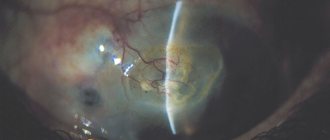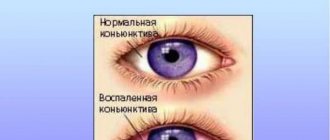Causes of conjunctivitis in pregnant women
Eye inflammation is associated with various factors. The main ones include:
- Presence of a foreign body in the eyes.
- Improper wearing of contact lenses, against this background, contact conjunctivitis can develop.
- Impact of allergens on the mucous membrane (plant pollen, house dust, cosmetics). In this case, allergic conjunctivitis occurs.
- Failure to comply with hygiene rules.
- Colds, flu, viral infections.
- In diseases of the ENT organs, a bacterial form of the disease may occur.
- Vitamin deficiency, malnutrition.
In each case, the reasons may be individual.
How to quickly cure conjunctivitis?
Step 1. It is important to determine what kind of conjunctivitis you will have to deal with. Most likely, only a specialist can do this, but in some cases you can determine the type of disease yourself.
Determine the type of conjunctivitis
Step 2. You need to make an appointment with a doctor, and in especially severe cases, call a specialist at home to establish an accurate diagnosis and receive a treatment regimen.
Make an appointment with a doctor
Step 3. If conjunctivitis is caused by an allergy, then it is important to eliminate the allergen from your life, and also take an anti-allergy drug, but only after consulting a specialist. And this should be the drug that is suitable for a pregnant woman.
Take the right medicine
Step 4. It is important to regularly clean the affected eyes with herbal decoctions, furatsilin or just water. It is only recommended to use clean, sterile wipes. Before cleansing your eyes, it is important to wash your hands thoroughly with soap, and after the procedure, too.
Clean your eyes regularly
Step 5. On the recommendation of a specialist, you can use any eye drops.
Use eye drops if necessary
Step 6. Applying compresses - cold or hot - alleviates the condition. It is recommended to use lint-free fabrics, and an individual compress is always applied to each eye.
Apply compresses
Step 7. It is important to temporarily stop wearing contact lenses and replace them with glasses for the period of treatment.
Temporarily remove contact lenses
Step 8. It is prohibited to use decorative cosmetics during the treatment of conjunctivitis.
Don't wear cosmetics
Video - Treatment during pregnancy
Symptoms
This pathology is accompanied by pronounced symptoms. Among them are:
- increased lacrimation;
- irritation and redness of the mucous membrane;
- swelling;
- feeling of dryness or sand in the eyes;
- sensitivity to light;
- painful sensations that intensify when blinking;
- purulent discharge, especially observed in the morning.
Sometimes patients with this disease experience weakness, headache, and increased body temperature. At the first suspicious signs, you should consult a doctor and not self-medicate. This is very important during pregnancy. Not all medications are suitable for expectant mothers, especially in the first trimester. Lack of treatment can cause serious consequences.
Photo
In the images you can see what eyes look like with this pathology:
How can traditional medicine help?
The following products are allowed to be used at home:
- It is necessary to pour 3 tablespoons of marshmallow root into a glass of boiling water and leave the mixture for at least 8 hours. To treat conjunctivitis, it is recommended to apply eye lotions with the prepared infusion.
- You can mix 2 teaspoons of rose hips and 200 ml of boiling water and leave the mixture to steep for half an hour. It is recommended to use the prepared product as a lotion or simply wash sore eyes with it.
A simple and effective folk remedy is treating an inflamed eye with tea. To do this, you can use black or green tea, placing bags on your eyes. It is possible to alleviate a woman’s condition and get rid of conjunctivitis with the help of compresses based on aloe, marshmallow, rose petals and cornflower flowers.
How to treat conjunctivitis in pregnant women? Representatives of traditional medicine have their own answer to this question: in their arsenal there are many means to eliminate the symptoms of the disease in expectant mothers. However, doctors warn that pregnancy is not the time for experiments, and before using certain folk recipes to treat conjunctivitis, a woman should consult an ophthalmologist.
Aloe decoction is also good for conjunctivitis. To prepare a healing remedy, you need to pour 50 g of finely chopped leaves of the plant into 500 ml of boiling water and leave for 1 hour.
If conjunctivitis occurs during pregnancy, how to treat the disease? To find the answer to this question, the expectant mother must consult a doctor.
It is not difficult to get rid of inflammation of the mucous membrane of the eyes, but it is very important to carry out treatment in a timely and correct manner in order to avoid complications and not harm the baby developing in the womb
To alleviate the condition, use eye wash solutions based on:
- chamomile;
- black and green tea;
- fennel;
- bay leaf;
- calendula and other plant components with antiseptic properties.
Herbal infusions are not used to eliminate allergic types of inflammation. They can aggravate a woman's condition. The use of such drugs internally is also prohibited, since many herbs are contraindicated during pregnancy. How to treat conjunctivitis in pregnant women should be discussed with your doctor.
- Aloe. Squeeze fresh aloe juice or buy it at the pharmacy. Mix juice and chilled boiled water in a ratio of 1 to 10 (in any quantities while maintaining the proportions).
- Altheum. Pour 4 tablespoons of dried roots with cooled boiled water and leave the product to infuse for a day. Strain.
- Cornflower or chamomile. Pour 2 tablespoons of dried flowers into a glass of boiling water, let cool and strain.
- Tea (black without additives). Prepare like chamomile or cornflower, but take only 1 teaspoon of tea leaves.
Attention! Rinse eyes with the chosen product every 2-3 hours. For the procedure you will need two cotton pads - one for each eye.
Use a generously moistened disc to sweep over the eyes from the inner corner to the outer, removing purulent and mucous discharge, as well as dried crusts.
Lotions and compresses help a lot:
- From dill. Extract the juice from fresh dill leaves. Soak cotton pads in it and apply to your eyes several times a day for 15 minutes.
- From potatoes. Apply grated raw potatoes mixed with egg white to your eyes for 10-15 minutes.
- From cucumber. Squeeze the juice out of the vegetable and add a little soda. Soak cotton pads in it and make a compress for 15 minutes.
- From tea and chamomile. You can not only wash your eyes with an infusion of tea and chamomile, but also make compresses with them.
Attention! Keep in mind that they are useless for viral, fungal and allergic diseases. However, this circumstance is mitigated by the fact that these types of conjunctivitis are not prohibited for expectant mothers to treat with medication
But the problem with bacterial infection is still relevant: it is undesirable to be treated with antibiotics.
Forms of conjunctivitis during pregnancy
There are a large number of types of conjunctivitis that can affect the human body. All of them are accompanied by inflammation of the mucous membrane. Only a doctor can determine the form of pathology after a full diagnosis. Basically, conjunctivitis is divided into:
- allergic;
- viral;
- bacterial;
- contact.
Once the etiology of each type has been determined, treatment can be selected accordingly.
Allergic
If a woman had allergic reactions before pregnancy, then in an interesting situation they tend to worsen.
The reason lies in the body’s incorrect reaction to various stimuli. These may include: plant pollen, animal hair, some medications, chemicals and household products. This form of pathology is accompanied by the following symptoms:
- unbearable itching;
- increased and uncontrolled lacrimation;
- sensitivity to light;
- redness;
- simultaneous damage to both eyes.
There is no discharge from the eyes. When severe, they may have a slimy consistency. If you eliminate contact with the irritant, the symptoms will go away on their own without taking medications.
Viral
Such inflammation can occur against the background of ARVI. This is due to the general damage to the body by pathogenic viruses. This type of conjunctivitis has characteristic symptoms:
- Initially, the inflammation affects one eye, and after a few days the second;
- severe lacrimation appears;
- severe swelling;
- mucous discharge from the eyes.
If the cause is associated with an adenoviral infection, then cough, rhinitis, and fear of light occur. If not treated in a timely manner, the pathology can spread to the cornea. Against this background, a decrease in visual acuity is observed. Dry eye syndrome may often occur after treatment. The herpetic form of conjunctivitis can occur due to pregnancy. This is due to a strong decrease in immunity, which contributes to the activation of the herpes virus. In this case, the following signs appear:
- the appearance of bubbles with liquid inside on the eyelids;
- if such a bubble bursts, pain, burning and severe itching appear;
- the appearance of severe headache;
- increase in body temperature.
Bacterial
This disease develops against the background of damage to opportunistic microorganisms. Among them are: streptococci, gonococci, pneumococci, staphylococci. Often the reason may be hidden in the presence of ARVI. In addition to a runny nose and cough, unpleasant symptoms appear in the eyes.
Failure to observe personal hygiene rules and touching your eyes with unwashed hands can lead to the development of this form of the disease. Typical symptoms include:
- profuse purulent discharge of yellow or green color;
- Initially, one eye is infected, and after a few days both;
- itching;
- sensitivity to light;
- swelling and redness of the conjunctiva.
Symptoms of the disease
Symptoms of conjunctivitis during pregnancy are similar to those in the classic form:
- a large amount of green mucous discharge that forms in the corners of the eyes, swelling of the eyelids, redness of the white membrane. Similar signs accompany the bacterial form of inflammation of the mucous membrane. Both visual organs or just one may be affected;
- severe hyperemia of the organs of vision and a feeling of itching, there is no discharge, but strong separation of the secretion of the lacrimal or Harderian glands (tear fluid) is possible. Symptoms accompany the viral form of the inflammatory process. During pregnancy, as in other cases, you may notice eye damage and signs of a common cold (chills, fever, migraine, cough);
- noticeable hyperemia of the eyes, severe lacrimation, characteristic itching, causing discomfort. If accompanied by rhinitis (runny nose), inflammation of the skin, and sneezing, it is likely that the doctor will diagnose an allergic type of conjunctivitis.
Diagnostics
There are many external and internal factors that provoke the development of conjunctivitis. It is often diagnosed against the background of other ophthalmological diseases. The doctor conducts a visual examination, listens to the patient’s complaints, and studies the medical history. To determine the cause and type of disease, he prescribes bacteriological tests and laboratory tests. It is important to determine the causative agent of the pathology in order to prescribe effective treatment. Improper therapy can lead to the development of chronic conjunctivitis.
Treatment
The treatment method can be determined by the doctor after confirming the diagnosis. During pregnancy, many drugs are prohibited. Therefore, complex therapy using folk remedies is often prescribed. Self-medication is strictly prohibited.
Medicines
After determining the cause of the disease, the doctor prescribes appropriate therapy. It mainly consists of taking antibacterial, antihistamine, painkillers, and anti-inflammatory drugs. It is also necessary to take immunostimulants. The duration and course of pregnancy should be taken into account. List of medications:
- To wash the eyes and eliminate secretions, use the following solutions: Furacilin, boric acid, a weak solution of potassium permanganate.
- Ointments for placing in the conjunctival sac are rarely prescribed.
- Eye drops are used taking into account the pathogen. Mainly prescribed: Tobrex, Ciloxan, Albucid. These drugs are not considered safe and are prescribed in extreme cases. Floxal is strongly not recommended for pregnant women.
Folk remedies
Traditional medicine can be used in the absence of an allergic reaction to plants. Therefore, before using them, you should consult your doctor. Such products are suitable only for topical use as compresses and infusions for rinsing:
- Chamomile. This is the safest plant. Dried flowers are used to prepare a decoction or infusion. A not very concentrated infusion is prepared. It is suitable for washing eyes. Has an antibacterial, antiseptic, anti-inflammatory effect. Not recommended for allergic conjunctivitis.
- Aloe. It is important to consider that a plant that is more than 3 years old has medicinal properties. You need to take a few leaves and squeeze the juice out of them. It is diluted with a small amount of water, and the finished solution is used for washing. Dry leaves can be used. They are poured with boiling water.
- Althea. For the infusion you will need the dried root of this plant. It should stand for 24 hours. After this, you can wash your eyes with it. The flowers also have medicinal properties and can be added to an infusion.
Before using such products, you should consult your doctor.
Medications
The selection of medications for the treatment of conjunctivitis in pregnant women is the responsibility of an ophthalmologist. Moreover, if the period is less than 12 weeks, then the use of any drugs is extremely undesirable, and doctors try to minimize drug therapy as much as possible. The patient is instructed to regularly wash her eyes using herbal decoctions: for example, chamomile or sage. But taking medications is possible only after permission from the ophthalmologist and gynecologist in severe cases.
During the 2nd and 3rd trimester, an ophthalmologist can prescribe most medications without fear of complications in the fetus. But drugs with hormonal components and heavy metal salts, and antibacterial drugs with toxic effects on the body are strictly prohibited. Before taking immunostimulants, you need to evaluate the pros and cons with a gynecologist.
The choice of medications depends on the cause of conjunctivitis:
- For viral diseases, antiviral drops and ointments are prescribed to be placed behind the eyelid. For example, Tebofen. To boost immunity, drugs with interferon can be used.
- For bacterial conjunctivitis, antibiotic drops (for example, Levomycetin) and antibacterial ointments (tetracycline has proven itself) are used.
- For conjunctivitis of an allergic nature, antihistamine therapy is used.
With proper and timely treatment, the disease goes away without a trace and does not affect the development of the child in any way.
Conjunctivitis is often a consequence of colds. The video will tell you how to treat them during pregnancy:
Conjunctivitis
is a disease of the mucous membrane of the eye caused by viruses, bacteria or allergens. This explains the fact that infectious conjunctivitis during pregnancy is much more common than allergic conjunctivitis. Against the background of reduced immunity during pregnancy, the female body is exposed to negative factors and can become a target for various infections.
Complications
If treatment was incorrect or untimely, the disease may become chronic. Therefore, treatment should be carried out by a doctor after determining the type and cause of conjunctivitis. All expectant mothers are most interested in the question of what consequences there may be for the baby. Contact and allergic conjunctivitis is not dangerous and goes away after the irritant is eliminated.
Chlamydia infection poses a potential risk to the child. Against the background of decreased immunity, the pathology manifests itself in this form if the woman is a carrier of the infection. This can cause the following negative consequences:
- intrauterine infection;
- premature release of water;
- premature birth;
- infection of the child during childbirth.
To avoid such consequences, it is necessary to undergo examination before conceiving the baby.
Prevention
It is very important to understand that if one eye festeres, then if hygiene rules are not followed, damage to the second can quickly occur. In order to avoid getting conjunctivitis, you should strictly observe sanitary rules and personal hygiene. Doctors do not recommend using decorative cosmetics during pregnancy. This can cause irritation and allergies. Also, do not rub your eyes or touch them with dirty hands.
During pregnancy, it is necessary to ensure that hand and face towels are individual. They must be washed often and must be ironed. Also, household utensils and other items must be personal. Only by following these recommendations can you reduce the risk of contracting this disease.











